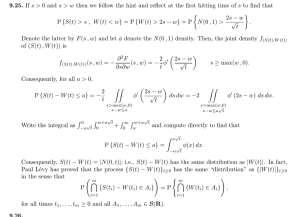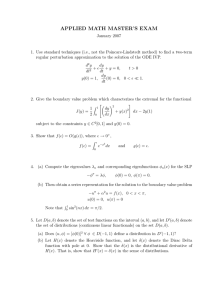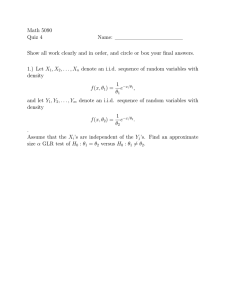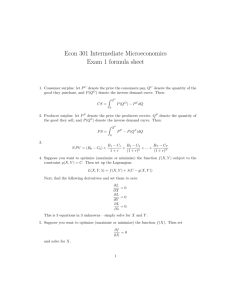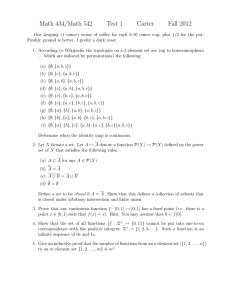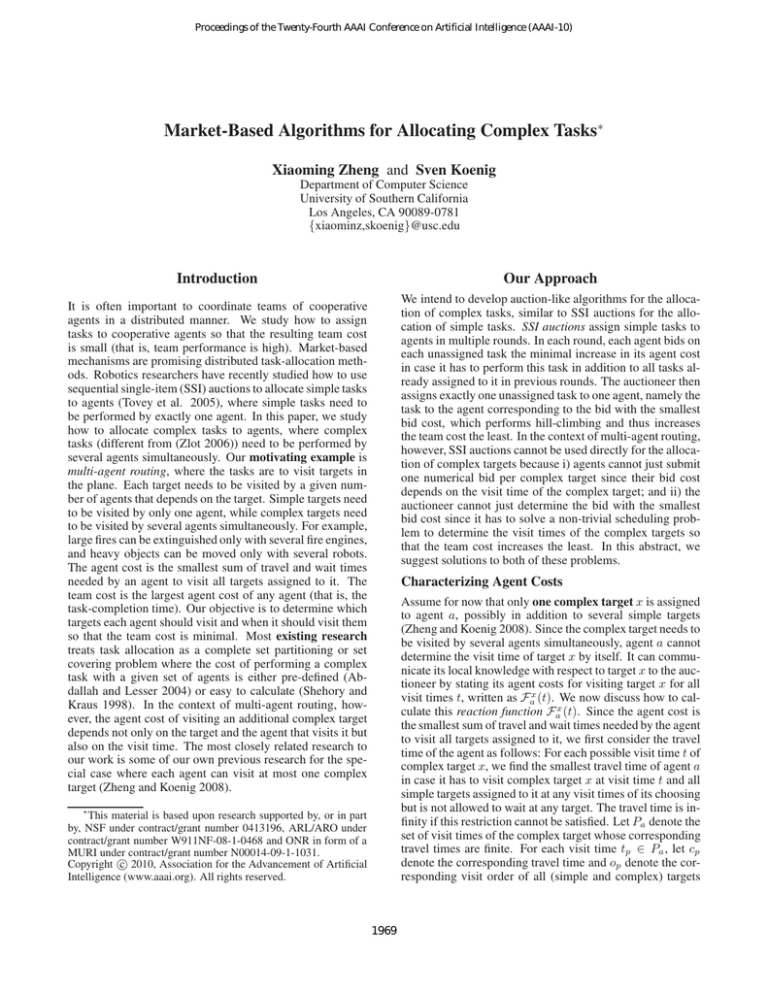
Proceedings of the Twenty-Fourth AAAI Conference on Artificial Intelligence (AAAI-10)
Market-Based Algorithms for Allocating Complex Tasks∗
Xiaoming Zheng and Sven Koenig
Department of Computer Science
University of Southern California
Los Angeles, CA 90089-0781
{xiaominz,skoenig}@usc.edu
Introduction
Our Approach
We intend to develop auction-like algorithms for the allocation of complex tasks, similar to SSI auctions for the allocation of simple tasks. SSI auctions assign simple tasks to
agents in multiple rounds. In each round, each agent bids on
each unassigned task the minimal increase in its agent cost
in case it has to perform this task in addition to all tasks already assigned to it in previous rounds. The auctioneer then
assigns exactly one unassigned task to one agent, namely the
task to the agent corresponding to the bid with the smallest
bid cost, which performs hill-climbing and thus increases
the team cost the least. In the context of multi-agent routing,
however, SSI auctions cannot be used directly for the allocation of complex targets because i) agents cannot just submit
one numerical bid per complex target since their bid cost
depends on the visit time of the complex target; and ii) the
auctioneer cannot just determine the bid with the smallest
bid cost since it has to solve a non-trivial scheduling problem to determine the visit times of the complex targets so
that the team cost increases the least. In this abstract, we
suggest solutions to both of these problems.
It is often important to coordinate teams of cooperative
agents in a distributed manner. We study how to assign
tasks to cooperative agents so that the resulting team cost
is small (that is, team performance is high). Market-based
mechanisms are promising distributed task-allocation methods. Robotics researchers have recently studied how to use
sequential single-item (SSI) auctions to allocate simple tasks
to agents (Tovey et al. 2005), where simple tasks need to
be performed by exactly one agent. In this paper, we study
how to allocate complex tasks to agents, where complex
tasks (different from (Zlot 2006)) need to be performed by
several agents simultaneously. Our motivating example is
multi-agent routing, where the tasks are to visit targets in
the plane. Each target needs to be visited by a given number of agents that depends on the target. Simple targets need
to be visited by only one agent, while complex targets need
to be visited by several agents simultaneously. For example,
large fires can be extinguished only with several fire engines,
and heavy objects can be moved only with several robots.
The agent cost is the smallest sum of travel and wait times
needed by an agent to visit all targets assigned to it. The
team cost is the largest agent cost of any agent (that is, the
task-completion time). Our objective is to determine which
targets each agent should visit and when it should visit them
so that the team cost is minimal. Most existing research
treats task allocation as a complete set partitioning or set
covering problem where the cost of performing a complex
task with a given set of agents is either pre-defined (Abdallah and Lesser 2004) or easy to calculate (Shehory and
Kraus 1998). In the context of multi-agent routing, however, the agent cost of visiting an additional complex target
depends not only on the target and the agent that visits it but
also on the visit time. The most closely related research to
our work is some of our own previous research for the special case where each agent can visit at most one complex
target (Zheng and Koenig 2008).
Characterizing Agent Costs
Assume for now that only one complex target x is assigned
to agent a, possibly in addition to several simple targets
(Zheng and Koenig 2008). Since the complex target needs to
be visited by several agents simultaneously, agent a cannot
determine the visit time of target x by itself. It can communicate its local knowledge with respect to target x to the auctioneer by stating its agent costs for visiting target x for all
visit times t, written as Fax (t). We now discuss how to calculate this reaction function Fax (t). Since the agent cost is
the smallest sum of travel and wait times needed by the agent
to visit all targets assigned to it, we first consider the travel
time of the agent as follows: For each possible visit time t of
complex target x, we find the smallest travel time of agent a
in case it has to visit complex target x at visit time t and all
simple targets assigned to it at any visit times of its choosing
but is not allowed to wait at any target. The travel time is infinity if this restriction cannot be satisfied. Let Pa denote the
set of visit times of the complex target whose corresponding
travel times are finite. For each visit time tp ∈ Pa , let cp
denote the corresponding travel time and op denote the corresponding visit order of all (simple and complex) targets
∗
This material is based upon research supported by, or in part
by, NSF under contract/grant number 0413196, ARL/ARO under
contract/grant number W911NF-08-1-0468 and ONR in form of a
MURI under contract/grant number N00014-09-1-1031.
c 2010, Association for the Advancement of Artificial
Copyright Intelligence (www.aaai.org). All rights reserved.
1969
assigned to the agent.1 We now include the wait time of the
agent as follows: Assume that agent a is required to visit
complex target x at visit time t. Without loss of generality, we assume that agents wait only at complex targets and
leave them immediately after their visit. For each visit time
tp ∈ Pa with tp ≤ t, visiting the targets in visit order op is
one way how agent a can visit complex target x at visit time
t. The resulting sum of travel and wait times is cp + t − tp ,
where cp is the travel time and t − tp is the wait time at the
complex target. The agent cost is the smallest sum of travel
and wait times. Thus, Fax (t) = mintp ∈Pa ,tp ≤t (cp + t − tp ).
The key idea here is to express a reaction function whose
domain is infinite with a finite number of values. We now
generalize this idea to the case where multiple complex targets are assigned to agent a, possibly in addition to several
simple targets. Let xa = (x1a , . . . , xka ) denote a vector of
complex targets assigned to agent a, where the complex targets are visited by the agent in the order specified by xa . For
each possible vector ta = (t1a , . . . , tka ) of visit times of the
complex targets in xa with t1a ≤ . . . ≤ tka , we find the smallest travel time of agent a in case it has to visit the complex
targets xa at visit times ta and all simple targets assigned to
it at any times of its choosing but is not allowed to wait at
any target. The travel time is infinity if this restriction cannot
be satisfied. Let Pa denote the set of vectors of visit times of
the complex targets whose corresponding travel times are finite. For each vector tp ∈ Pa of visit times, let cp denote the
corresponding travel time and op denote the corresponding
visit order of all (simple and complex) targets assigned to
the agent. Assume that agent a is required to visit the complex targets xa at visit times ta . For each vector tp ∈ Pa of
visit times with 0 ≤ t1a − t1p ≤ . . . ≤ tka − tkp , visiting the
targets in visit order op is one way how agent a can visit the
complex targets xa at visit times ta . The resulting sum of
travel and wait times is cp + tka − tkp , where cp is the travel
time and tka − tkp is the total wait time at all complex targets.
The agent cost is the smallest sum of travel and wait times.
Thus, Faxa (ta ) = mintp ∈Pa ,0≤t1a −t1p ≤...≤tka −tkp (cp +tka −tkp )
for the visit order of the complex targets specified by vector
xa . The reaction functions for all possible visit orders of the
complex targets assigned to an agent then specify its agent
costs for visiting its complex targets for all visit times.
of the complex target such that at least one agent does not
wait at the complex target. Then, the optimal visit time is
mint∈T maxa∈A Fax (t). This can be seen as follows: For
any visit time t ∈
/ T of the complex target, all agents have
to wait at complex target x. Let s denote the smallest wait
time of any agent. Then, the team cost decreases by s if all
agents visit complex target x at visit time t′ = t − s, where
t′ ∈ T . Thus, the previous team cost was not minimal. The
key idea here is to calculate the minimization over an infinite
number of potential visit times by considering only a finite
number of values. We now generalize this idea to the case
where multiple complex targets can be assigned to each
agent, possibly in addition to several simple targets. Assume
that the auctioneer has to determine when a set of agents A
should visit the complex targets assigned to them so that the
team cost is minimal. Let x = (x1 , . . . , xn ) denote the vector of complex targets assigned to the set of agents, where
each complex target is assigned to at least one agent and the
complex targets are visited in the order specified by x. Let
T denote the set of vectors t = (t1 , . . . , tn ) of visit times
of the complex targets such that, for each complex target, at
least one agent does not wait at the complex target. Then,
mint∈Rn+ maxa∈A Faxa (ta ) = mint∈T maxa∈A Faxa (ta ),
where xa and ta are the projections of x and t onto the
complex targets assigned to agent a and their visit times,
respectively.
Conclusions
We extended previous research to the allocation of complex
tasks, where complex tasks need to be performed by several
agents simultaneously. We proposed reaction functions to
succinctly characterize the agent costs for executing complex tasks at given times and illustrated an important property of the execution times of complex tasks that minimize
the team cost, which facilitates winner determination by the
auctioneer. It is future work to build an agent-based coordination system similar to SSI auctions that exploits this property.
References
Abdallah, S., and Lesser, V. 2004. Organization-based cooperative
coalition formation. In Proceedings of the IEEE/WIC/ACM International Conference on Intelligent Agent Techonology, 162–168.
Shehory, O., and Kraus, S. 1998. Methods for task allocation
via agent coalition formation. Artificial Intelligence 101(1–2):165–
200.
Tovey, C.; Lagoudakis, M.; Jain, S.; and Koenig, S. 2005. The
generation of bidding rules for auction-based robot coordination.
In Parker, L.; Schneider, F.; and Schultz, A., eds., Multi-Robot Systems: From Swarms to Intelligent Automata. Springer. 3–14.
Zheng, X., and Koenig, S. 2008. Reaction functions for task allocation to cooperative agents. In Proceedings of the International
Joint Conference on Autonomous Agents and Multiagent Systems,
559–566.
Zlot, R. 2006. An Auction-Based Approach to Complex Task Allocation for Multirobot Teams. Ph.D. Dissertation, Robotics Institute,
Carnegie Mellon University, Pittsburgh, PA.
Determining Optimal Visit Times
Assume again that only one complex target is assigned to
each agent, possibly in addition to several simple targets
(Zheng and Koenig 2008). Assume further that the auctioneer has to determine when a set of agents A should visit the
complex target x assigned to all of them so that the team
cost is minimal. Per definition, the optimal visit time is
mint∈R+ maxa∈A Fax (t). It can be determined in finite time
as follows: Let T = ∪a∈A Pa denote the set of visit times
1
Pa can be constructed in finite time as follows: First, construct
all possible visit orders of all (simple and complex) targets assigned
to the agent. Second, for each visit order, find the visit time of the
complex target in case the agent visits all targets in the given visit
order without waiting at any target. Pa is the set of all such visit
times. Third, if more than one visit order results in the same visit
time, keep only the one with the smallest travel time.
1970

